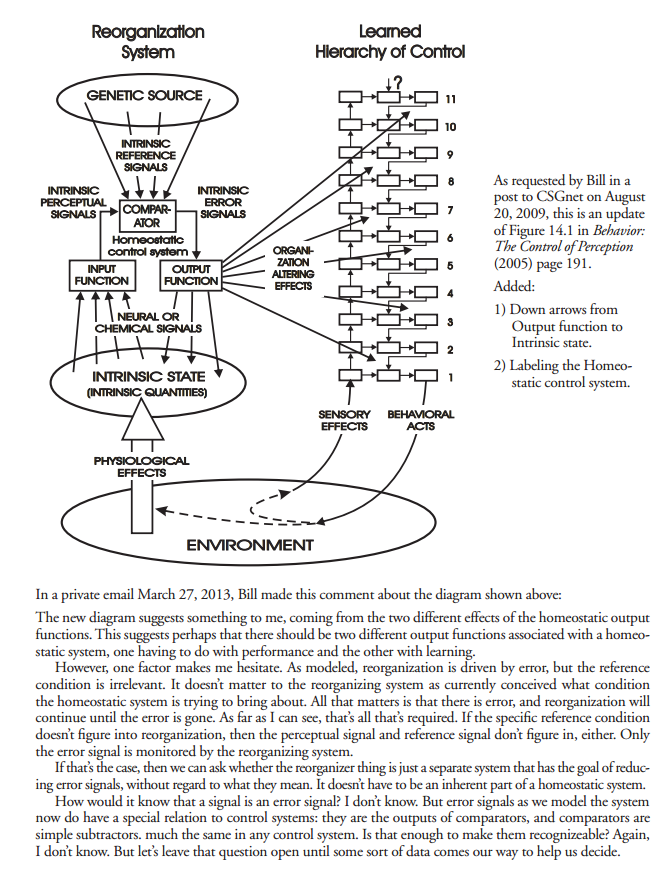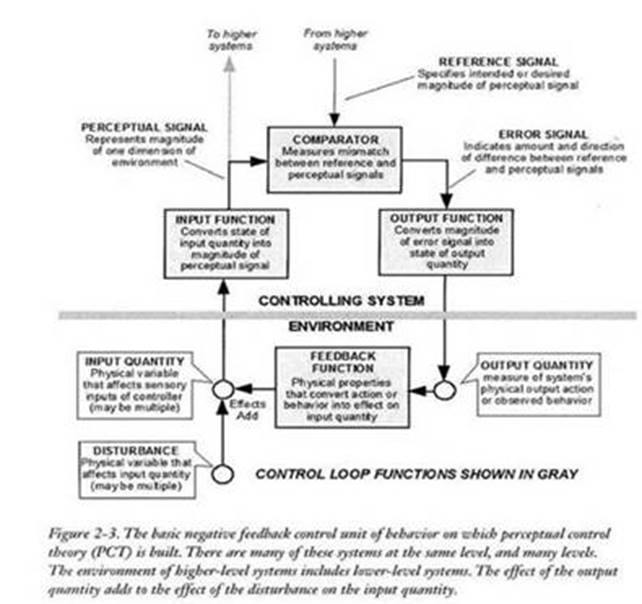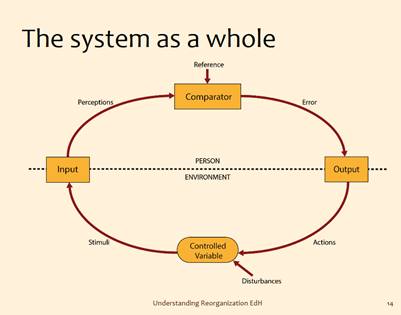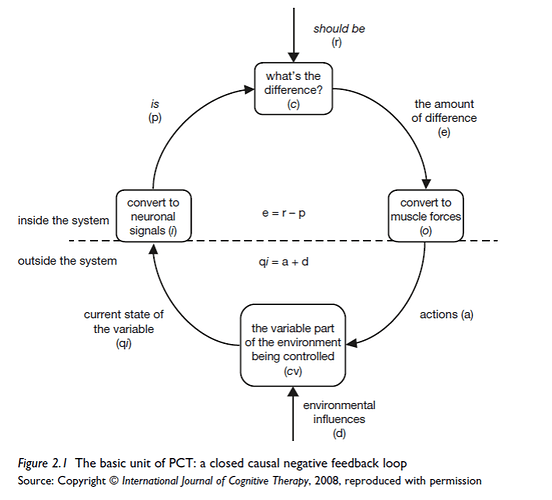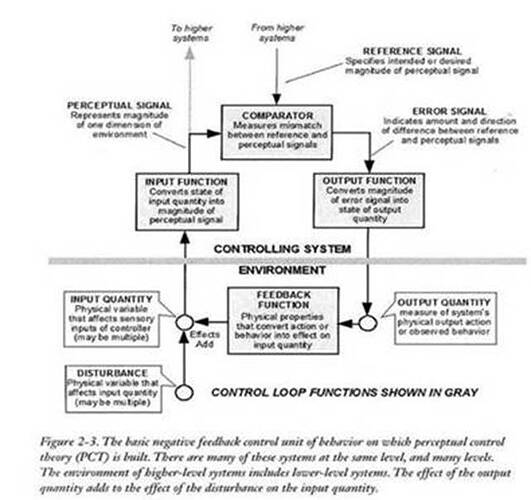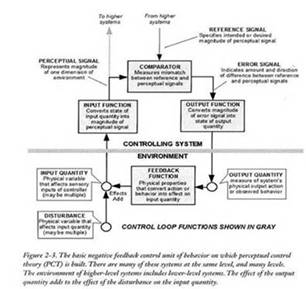I just extracted some problems from Martin answers.
MT : Right. That’s why I mentioned the circuit based on Seth and Friston, which makes available to upper levels all three of the variables connected to the comparator, rather than just the perceptual value.
HB : I’ve asked you two times Martin whether Friston is saying that “references” are “tarvelling” upward hierarchy and you didn’t answer yet ? Andi f that is true I’m interested how ? Can you change diagram on p. 191 (B:CP, 2005) so that we can see clearly how it looks like if you put Fristons’ “control” knowledge into PCT ? Talking and phylosophing is not helping much to understand what Friston wanted to say.
MT : A related question, though it may not seem like one to you at this moment: In your model, must the perceptual value for the top-level “control of control” be represented by a neural current, or could it be something else, such as the concentration of some biochemical?
MT : There may be no consensus, but it is generally understood that perception is controlled by influencing something in the environment that I call the CEV (corresponding environmental variable),
HB : I don’t understand Martin of what kind of generality you are talking about ? I’m sure that at least me and Rick do not agree with what you are saying. I thought that about generality in PCT have to decide PCT statements. Why didn’t you use them ?
HB : What of things you are saying have to do with PCT ? Why didn’t you support your findings with some PCT statements and diagrams ? By my oppinion you are saying something like Rick with his “controlled variable” in outer environment only you are using a little bit different language. For Rick “control” is happening in outer environment. Can you please show us what your statement above has to do with definition of control in PCT ?
CONTROL : Achievement and maintenance of a preselected state in the controlling system, through actions on the environment that also cancel the effects of disturbances.
Our only view of the real world is our view of the neural signals that represent it inside our own brains. When we act to make a perception change to our more desireble state – when we make the perception of the glass change from »on the table« to »near the mouth« - we have no direct knowledge of what we are doing to the reality that is the origin of our neural signal; we know only the final result, how the result looks, feels, smells, sounds, tastes, and so forth…It means that we produce actions that alter the world of perception…
HB : I think that statement above shows how PCT function. How your statement fi tinto it ? And how your statement fi tinto “Feedback function” ?
FEED-BACK FUNCTION : The box represents the set of physical laws, properties, arrangements, linkages, by which the action of this system feeds-back to affect its own input, the controlled variable. That’s what feed-back means : it’s an effect of a system’s output on it’s own input
HB : I’m always inviting anybody who is discovering new ways in PCT inetrpretation to give some example how statement works in practice. Can you explain to us how you stament function when people are just observing ? I’ll give PCT example of how PCT function in practice. And I’ll use Ricks example :
RM (earlier) : Sleeping is a tough one but I think it is controlling done by the autonomic nervous system that has the aim of keeping some intrinsic physiological variables in genetically determined reference states.
And the last thing. Can you please explain to us how your statment fit into PCT diagrams B:CP (p.191) and LCS III ?
HB : Eva. Diagram which you are mentioning (Tim, Marken, Tai) is wrong. It has a litle to so with PCT diagrams. There is no consensus about value of clear PCT diagrams mostly thankfull to Rick and Fred. It seems that members are inventing their own diagrams in accordance to the state they understand PCT.
···
From: Martin Taylor (mmt-csg@mmtaylor.net via csgnet Mailing List) csgnet@lists.illinois.edu
Sent: Friday, January 25, 2019 11:52 PM
To: csgnet@lists.illinois.edu
Subject: Re: Have your cake and eat it: understanding reorganization
[Martin Taylor 2019.01.25.16.28]
[Eva de Hullu 2019.01.25.14.33]
Dear all,
Thank you all for your additions, comments, suggestions and compliments. I will need some time to process and integrate these ideas. Do some science, in the words of Martin J
So far, from the comments of Warren, I get the hunch that the resolution of conflict through new insight/a new combination of perceptions that I see in MOL – having my cake and eat it – might not actually represent reorganization. In this example, no new control systems are needed, parameters of input and output functions don’t have to shift. Just the content, values of these functions change. In MOL literature (books by Carey and Mansell) however, this process is labeled as reorganization. So if this is not reorganization, what is it?
- If I cut off a main branch of a tree and the tree grows a new branch so that it doesn’t fall (balance is restored).
I’m not sure whether you are asking for a PCT analysis of what happens in these situations, or whether what happens should be labelled “reorganization”. I’ll assume the latter and offer my own answers, because I suspect the work "reorganization means different things to different people, and a PCT analysis without experimental test is usually both complicated and non-unique.
A1. There is reorganization, because the physiological control systems in the new branch are not physically the ones that were in the old branch. New ones had to be built according to the old plan. The plan might be genetic, but the actual construction of the control systems is reorganization within the lifespan of that individual tree.
- If I learn the Russian alphabet, I develop new references for symbols that were previously unknown to me.
A2. Yes reorganization. You don’t learn new references by themselves. You learn new perceptual functions, and with them the reference configurations you would want the new perceptions to match when you wrote the letters. To learn the language beyond he alphabet, you had to learn a lot of new perceptual functions at many levels, from the spatial configurations that are and are not Cyrillic letters to the Russian cultural understandings that give meanings to words in specific contexts (such as “red” having some of the connotations we give to “gold”, if I understand correctly).
- If I was conflicted about eating cake or not, and after having a good look at the conflict, decide that it’s okay to want to eat the cake and keep it too, feel no longer conflicted.
A3. I don’t know what happens there, but I don’t think reorganization is involved. Years ago, I used to describe three different kinds of PCT: !. The strict HPCT version in Bill Powers’s writings, 2. relaxed HPCT that allows possibilities such as lateral influences within levels, control of gain and tolerance, different types of perceptions than the eleven specified by Bill, and between-level feedback loops, but keeps the basic hierarchic structure, and 3. perceptual control using a non-hierarchical structure.
I don’t think what you describe can happen in type 1, because if you are still controlling both perceptions, you have a sustained conflict. You have to stop controlling one or the other to stop the conflict. In type 2, what you describe is not reorganization, but could be control of tolerance, allowing one or both perceptions to differ from their reference values, but tolerably so which results in zero error being sent to the output function. Or it could be control of gain, setting one or both gains to or near zero so there is no output, which is where the conflict exists. In type 3, all bets are off. The particular structure would have to be specified before it would be possible to figure out an answer. (Either way, if someone else eats the cake, the conflict goes away – thought there might be a new one:-)
- If a client in therapy realizes for the first time that she can see herself as both vulnerable and strong.
A4. Could be reorganization, if a perceptual function is created for the joint perception, some function of the amount of vulnerability and of strength. That seems to be what you propose.
- If a child learns to ride the bike and is finally able to control keeping the bike stable.
Definitely reorganization. Lots of parameter variation, and maybe the construction of new perceptual functions of the dynamic view of the world available only from a bicycle.
So does reorganization mean that new control systems are added in the hierarchy or new connections are made (as in Ashby’s example of the homeostatic system that made a new wiring after another was cut)?
It can mean that, but need not. Typically, and in Bill’s reorganization demonstrations such as “The Little Man” and “Arm 2” the control systems are pre-specified and do not change.
One thing to keep in mind with these demos is that the external environment is “without form and void” – it has no complexities sch as objects in it. The complexities are all inside the organism. That makes a difference. In MoL, the person is having problems in a very complex real world, a world that has in it many control systems that might be disturbed or otherwise affected by one’s actions.
To have a cake and eat it is a problem in a simple world that doesn’t include, for example, a friend or a stranger who might also want that last piece of cake and would probably eat it if you chose “have my cake”. Your conflict might go away if you perceived the person to be a friend. My point is that reorganization is about living in a real world, not in an empty world using a body that was evolved to facilitate control in a complex one.
Should the resolution of conflict through awareness that does not involve new control systems (new skills) be called something else? Am I missing something important?
I don’t know if you are missing anything, important or not. Time will tell.
I’ll also ask the MOL mailinglist for input on this subject later, as soon as I get some grip on all the new ideas.
Other aspects that I need to consider:
- WM and MT: The time scale of reorganization related to the level.
- MT: What do Seth and Friston (2016) have to say about reorganization.
I don’t think that concept is part of their conceptual world (the free-energy thermodynamic driving of self-organized systems in a far-from-equilibrium state. But the circuit they derive from that basis is directly mappable onto the Powers hierarchy, with just name changes. Reorganization may well follow the same thermodynamic principles – I might almost say that it must do so – but Powers’s e-coli method of reorganization is not mappable onto anything I know of in the “free-energy” conceptual world.
- MT: How could new levels be created between the control level as top level and other levels?
- MT: Q1 How could the output function also transmit an error function to the input in the same level? [I have no idea, my problem is to understand where the error travels to, and how].
Right. That’s why I mentioned the circuit based on Seth and Friston, which makes available to upper levels all three of the variables connected to the comparator, rather than just the perceptual value.
A related question, though it may not seem like one to you at this moment: In your model, must the perceptual value for the top-level “control of control” be represented by a neural current, or could it be something else, such as the concentration of some biochemical?
- MT: Q2 How would perception of control [not a state of the environment] occur? What would control perceptions [references] look like?
- WM: How are intrinsic control systems involved in the model I propose (check dissociation chapter).
- HB: The control loop I used was derived from the picture below, in Carey, Mansell & Tai (2015). I wasn’t aware that there’s no concensus about the location of the controlled variable in the environment. I noticed that in building the PCT hierarchy (also depicted in the same book), it’s easy to leave the CV out. The way I understand it actually, we control our perceptions, which are in fact internal representations of the environmont and thus inside the organism. In the hierarchy, the external world is only connected to the lowest level of the perceptual hierarchy, the intensity level, through our senses. The rest is internal, build up from combinations of perceptions above that level.
MT : There may be no consensus, but it is generally understood that perception is controlled by influencing something in the environment that I call the CEV (corresponding environmental variable), and that the effects on the CEV are the only way anyone outside can tell that control is occurring. Whether the CEV is must be a material entity, can be a complex function of environmental states that affect the sensors, or can be something more abstract, that is a matter on which there is little agreement. My view is that the CEV is whatever is influenced in the environment that results in changes to the perceptual value. Its form is determined by all the perceptual functions that together produce the perceptual value from current and past sensed variable and possibly from imagination.
What is mathematically true is that the perception cannot be better controlled than the CEV, and vice-versa, so it is often said that the environmental variable is actually controlled. That sloppy natural way of talking bout it is something to which Boris objects strongly, for reasons that remain obscure to me, especially since it is the effect of control on the environment that keeps us alive, not the fact of control of our perceptions.
- HB: Is B:CP (2005) the same as the 1973 book or an update? I found a PDF of the 1973 book and can’t find the diagram you speak of. I’ll study the diagrams from and your ideas about that and see if I get it.
2005 has a new Chapter 17 on emotion that Bill wanted in the earlier book but was persuaded to omit. I think Boris is referring to Figure 14.1, which is probably the same number in the 1973 book. Not easily being able to find a PDF of the book, I can’t check. (I used to have a hard copy, but I lent it to someone many years ago). If you have a link, it would be nice to see it.
Martin
Kind regards,
Eva
![cid:image001.png@01D4B5B0.134641B0]()
Carey, T. A., Mansell, W., & Tai, S. J. (2015). Principles-Based Counselling and Psychotherapy - A Method of Levels approach.
Carey, T. A. (2008b). Perceptual control theory and the Method of Levels: Further contributions to a transdiagnostic perspective. International Journal of Cognitive Therapy, 1(3), 237–255.
From: “Boris Hartman” csgnet@lists.illinois.edu
Sent: Friday, January 25, 2019 10:03 AM
To: csgnet@lists.illinois.edu
Subject: RE: Have your cake and eat it: understanding reorganization
Hi Eva and Warren,
Sorry to jump in….
From: “Hullu, Eva de” (eva.dehullu@ou.nl via csgnet Mailing List) csgnet@lists.illinois.edu
Sent: Thursday, January 24, 2019 9:25 PM
To: Warren Mansell wmansell@gmail.com; fwnickols@gmail.com
Cc: csgnet@lists.illinois.edu
Subject: RE: Have your cake and eat it: understanding reorganization
Hi Warren,
I find that drawing diagrams helps in understanding what I’m trying to get across. In explaining PCT to my colleagues I found it difficult to explain the reorganization system. It was the messy part, while explaining control and the role of conflict were fairly easy. So I hope this discussion helps me find a diagram that could be part of the bigger presentation (in which audio would be a part, sounds like fun).
HB : Certainly. Reorganization is difficult to explain because it does not have scientific ground. It’s just Bills “huntch” upon some other authors that organisms could function in that way :
Bill P :
Reorganization is a blanket term that means changing the way the nervous system is internally connected.
The reorganization system doesn’t stop altering behavioral organization when something useful, reasonable, wise, or socially responsible is learned. It stops when intrinsic error goes to zero.
The concept of error-driven reorganization is a distinct departure from traditional notions of the causes of learning.
The reorganization idea is essentially the reversal image of the idea of reinforcement. Under the reorganization concept behavior continually changes as long there is intrinsic error. When an effect of behavior is to reduce intrinsic error, the next change in organization is delayed, so that behavior that happened to reduce intrinsic error persists a little longer. When the behavioral organization is found that reduces intrinsic error to zero (or whatever the required lower threshold is), the behavioral organization that then exists simply continues to operate unmodified.
So under reinforcement theory, a reinforcement effects of behavior has a positive effect on producing the same behavior, while under reorganization theory, a beneficial effects of behavior reduces the changes that the organization producing that behavior will be altered by further reorganization.
Bill P (B:CP) :
My objective in the remainder of this chapter is to develop a theory of reorganization: only this kind of theory can account for the existence of an adult’s hierarchy of control systems.
The concepts however, can be extended beyond my application of them. Nearly everyone who has worked on self-organizing systems has used principles like mine; I am merely adapting what others have done to a specific model.
HB : An important point is that diagram on p. 191 (B:CP, 2005) and problem about “reorganization” originated in Ashby’s idea of double feed-back. In diagram on p. 191, it can be seen clearly in environmental disturbances affecting “control hierarchy” and “Intrinsic variables” which are in Ashby’s theory called “essential variables”.
Bill P :
I took this idea, incidentally, from the cyberneticist W. Ross Ashby because I thought he was right, though I couldn’t prove it.
Bill P (B:CP) :
My model is direct extension of Ashby’s concept of “ultrastability”, the property intended be demonstrated by this uniselector-equipped homeostat. Ultrastability exists when a system is capable not only of feedback control of behavior-affected perception, but of altering the properties of the control system, including how they perceive and act, as means of satisfying the highest requirements of all survival.
Bill P :
Human reorganization capabilities are demonstrated by the so-called plasticity of the nervous system.
HB : It seems that some points in Bills’ theory about reorganizing of nervous system originated also from Maturana. Plasticity of nervous system in widely used in his book “Tree of knowledge”.
HB : I think that term reorganization quite good describes what is generally happening organism and in nervous system (hierarchy), and how learning take place, but it needs scientific support. It can’t stay “blanket term”. So I think as I wrote many times before that serious scientific study and project is needed to finish diagram on p.191 (B:CP, 2005).
Regards,
Boris
WM: Certainly Bill used overall error across perceptual control systems as one possible intrinsic variable that is minimised through reorganisation. Personally I feel that this is more relevant to an infant than an adult human. Accounts of tolerating huge ‘intrinsic’ hardship - such as Frankl’s traumatisation, appear to be transcended by maintaining control of one’s (existential) (higher level) principles rather than by regaining control per se. However as Frankl was probably an exception, maybe it depends on the individual as to which variable is used to reference the need for reorganisation, and the focus of awareness could dictate this.
EdH: Let me check if I get the right perception. Infants are developing their perceptual system. Their variety in input and output is limited. In that situation, any error would look like overall error (there’s something wrong means all is wrong). In an adult system (not just human,any developed organism) one would expect error to remain specific to the level that is involved (you’re probably able to tell at which level something’s wrong). The diagram expresses an adult control system. If this diagram doesn’t allow specification of the location of error, it’s not right yet.
I look at it this way. Perceptions are nested levels. Say I have error at the level of sensation (L2), and somehow this error will be fed back into the input at L2 (following the orange arrows at page 17). Then, at the top level, this signal will arrive intact, as a L2 perception + error nested in L3 configuration etc. The error is not overall, but contained within the level.
I’m not sure I understand your comment about Frankl. Isn’t it right that reorganization is a very individual process, since the references are very specific to the individual? I think extreme hardship such as Frankl is usually endured by dissociation, but in his case he remained conscious (I think) and reorganized at the highest perceptual level, he chose what was important to him. Through this reorganization he regained control (the top level) (as much control as was possible).
Martin provided some literature on the way error can be transmitted. Thank you, Martin, I’ll look into that!
MT: Your specific question, as to whether the error value can be perceived, is a question to be asked of Nature. The “standard model” of HPCT says “No”. But there is a structural model based on one proposed by Seth and Friston (2016) that I have posted a couple of times to CSGnet in which what is passed up to the “+1” perceptual function is not a set of “zero-level” perceptual values, but the set of “zero-level” reference and error values. Since the “+1” perceptual function can recreate each zero-level perceptual value from the zero-level reference and error, this structure can perform exactly the same as the Powers structure, while allowing extra possibilities such as yours.
WM: Second point, just checking - reorganisation alters the enduring properties of control systems such as the input and output functions but not signals themselves, which are emergent.
EdH: Thank you for clarifying, I paraphrased this incorrectly into random changes to input and output. So it should be random changes to the parameters of input and output functions.
Warren, could it be the case that we are discussing two different systems?
I am looking for a way to visualize what I see happening in a MOL conversation: the emergence of ‘insight’, the resolution of conflict. But now I suddenly doubt if that’s what we call reorganization. There is the reorganization that takes place in a developing system, in which new levels are added to the system and new control systems are integrated (indeed, in my model between the control system and the highest perceptual level). And there’s what happens to the signals in an existing control system when conflict is resolved internally.
Eva
From: Warren Mansell wmansell@gmail.com
Sent: Thursday, January 24, 2019 5:29 PM
To: fwnickols@gmail.com
Cc: Hullu, Eva de eva.dehullu@ou.nl; csgnet@lists.illinois.edu
Subject: Re: Have your cake and eat it: understanding reorganization
Hi Eva,
That looks like a lot of hard work already! Very nice slides especially the diagrams.
Do you plan for an audio to accompany it?
Certainly Bill used overall error across perceptual control systems as one possible intrinsic variable that is minimised through reorganisation. Personally I feel that this is more relevant to an infant than an adult human. Accounts of tolerating huge ‘intrinsic’ hardship - such as Frankl’s traumatisation, appear to be transcended by maintaining control of one’s (existential) (higher level) principles rather than by regaining control per se. However as Frankl was probably an exception, maybe it depends on the individual as to which variable is used to reference the need for reorganisation, and the focus of awareness could dictate this.
Second point, just checking - reorganisation alters the enduring properties of control systems such as the input and output functions but not signals themselves, which are emergent.
Hope that proves helpful to the discussion,
Warren
Qqq
On 24 Jan 2019, at 15:31, Fred Nickols (fwnickols@gmail.com via csgnet Mailing List) csgnet@lists.illinois.edu wrote:
Fred Nickols (2019.01.24.1029 ET)
Eva:
Bravo! Nice piece of work. Welcome to the club. I especially like your notion about control being at the top of the hierarchy. Looking forward to more from you.
On Thu, Jan 24, 2019 at 10:21 AM “Hullu, Eva de” csgnet@lists.illinois.edu wrote:
Dear all,
In getting a grip on PCT, I find the most difficult part is visualizing how reorganization works. As I understand so far, this is a concept that’s still very much under construction in the theory. Which also means that there’s room for theory development J
In my thinking process, I’ve prepared a document with diagrams and ideas about reorganization, in which I took Powers’ diagram as represented in Marken & Carey (2015) as a starting point but ultimately ended up with the sense that the reorganization diagram should be simpler, not more complex.
I’d really appreciate your thoughts and comments, either in this mailing list or as comments on the slides.
Have your cake and eat it: https://docs.google.com/presentation/d/1N_hxZ-0AWUcEO_QOQ47HCyqtJVq0WpViaDjpaIlKF-s/edit?usp=sharing
Kind regards,
Eva
Marken, R. S., & Carey, T. A. (2015). Understanding the Change Process Involved in Solving Psychological Problems: A Model-based Approach to Understanding How Psychotherapy Works. Clin Psychol Psychother, 22(6), 580–590. https://doi.org/10.1002/cpp.1919
Deze e-mail is uitsluitend bestemd voor de geadresseerde(n). Verstrekking aan en gebruik door anderen is niet toegestaan. Open Universiteit sluit iedere aansprakelijkheid uit die voortvloeit uit elektronische verzending. Aan de inhoud van deze e-mail en/of eventueel toegevoegde bijlagen kunnen geen rechten worden ontleend.
This e-mail is intended exclusively for the addressee(s), and may not be passed on to, or made available for use by any person other than the addressee(s). Open Universiteit rules out any and every liability resulting from any electronic transmission. No rights may be derived from the contents of this message.
–
Fred Nickols
Chief Toolmaker
Distance Consulting LLC
“Assistance at A Distance”
www.nickols.us
Deze e-mail is uitsluitend bestemd voor de geadresseerde(n). Verstrekking aan en gebruik door anderen is niet toegestaan. Open Universiteit sluit iedere aansprakelijkheid uit die voortvloeit uit elektronische verzending. Aan de inhoud van deze e-mail en/of eventueel toegevoegde bijlagen kunnen geen rechten worden ontleend.
This e-mail is intended exclusively for the addressee(s), and may not be passed on to, or made available for use by any person other than the addressee(s). Open Universiteit rules out any and every liability resulting from any electronic transmission. No rights may be derived from the contents of this message.
Deze e-mail is uitsluitend bestemd voor de geadresseerde(n). Verstrekking aan en gebruik door anderen is niet toegestaan. Open Universiteit sluit iedere aansprakelijkheid uit die voortvloeit uit elektronische verzending. Aan de inhoud van deze e-mail en/of eventueel toegevoegde bijlagen kunnen geen rechten worden ontleend.
This e-mail is intended exclusively for the addressee(s), and may not be passed on to, or made available for use by any person other than the addressee(s). Open Universiteit rules out any and every liability resulting from any electronic transmission. No rights may be derived from the contents of this message.
